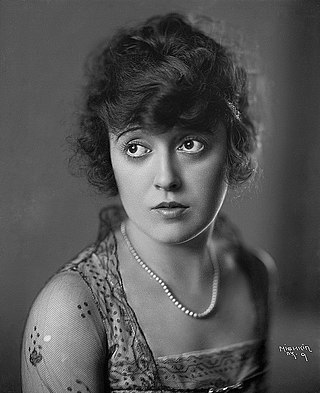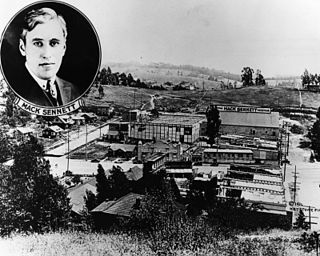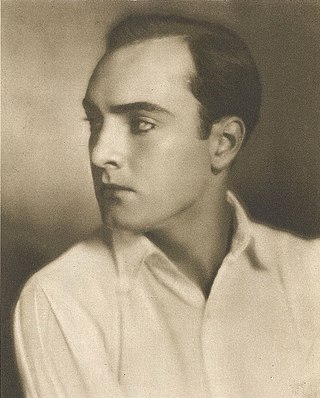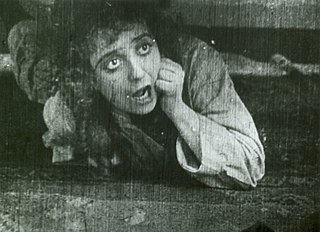
The Keystone Cops are fictional, humorously incompetent policemen featured in silent film slapstick comedies produced by Mack Sennett for his Keystone Film Company between 1912 and 1917.

Mack Sennett was a Canadian-American producer, director, actor, and studio head who was known as the "King of Comedy" during his career.

Tillie's Punctured Romance is a 1914 American silent comedy film directed by Mack Sennett and starring Marie Dressler, Mabel Normand, Charlie Chaplin, and the Keystone Kops. The picture is the first feature-length comedy and was the only feature-length comedy made by the Keystone Film Company.

Amabel Ethelreid Normand, better known as Mabel Normand, was an American silent film actress, director and screenwriter. She was a popular star and collaborator of Mack Sennett in their Keystone Studios films, and at the height of her career in the late 1910s and early 1920s had her own film studio and production company, the Mabel Normand Feature Film Company. On screen, she appeared in twelve successful films with Charlie Chaplin and seventeen with Roscoe "Fatty" Arbuckle, sometimes writing and directing films featuring Chaplin as her leading man.


Mack & Mabel is a musical with a book by Michael Stewart and music and lyrics by Jerry Herman. The plot involves the tumultuous romantic relationship between Hollywood director Mack Sennett and Mabel Normand, who became one of his biggest stars. In a series of flashbacks, Sennett relates the glory days of Keystone Studios from 1911, when he discovered Normand and cast her in dozens of his early "two-reelers", through his creation of Sennett's Bathing Beauties and the Keystone Cops to Mabel's death from tuberculosis in 1930.

Mack Swain was a prolific early American film actor, who appeared in many of Mack Sennett’s comedies at Keystone Studios, including the Keystone Cops series. He also appeared in major features by Charlie Chaplin and starred in both the world's first feature length comedy and first film to feature a Movie-within-a-movie premise.

Ford Sterling was an American comedian and actor best known for his work with Keystone Studios. One of the 'Big 4', he was the original chief of the Keystone Cops.

Chester Cooper Conklin was an early American film comedian who started at Keystone Studios as one of Mack Sennett’s Keystone Cops, often paired with Mack Swain. He appeared in a series of films with Mabel Normand and worked closely with Charlie Chaplin, both in silent and sound films.

George O'Hara was an American motion picture actor and screenwriter of the silent film era.

Frank Richard Jones was an American director, screenwriter, and producer.

Araminta Estelle "Minta" Durfee was an American silent film actress from Los Angeles, California, possibly best known for her role in Mickey (1918).

Alice Howell was a silent film comedy actress from New York City. She was the mother of actress Yvonne Howell.

Mabel's Strange Predicament is a 1914 American film starring Mabel Normand and Charles Chaplin, notable for being the first film for which Chaplin donned the costume of The Tramp, although his appearance in the costume in Kid Auto Races at Venice was released first. The film was directed by Normand and produced by Mack Sennett.

The Fatal Mallet is a 1914 American-made motion picture starring Charles Chaplin and Mabel Normand. The film was written and directed by Mack Sennett, who also portrays one of Chaplin's rivals for Normand's attention.

A Noise from the Deep is a 1913 American short silent comedy film starring Mabel Normand and Roscoe "Fatty" Arbuckle. The film was directed and produced by Mack Sennett and also features the Keystone Cops on horseback. A Noise from the Deep still exists and was screened four times in 2006 in the Museum of Modern Art in New York City as part of a 56-film retrospective of all known surviving Arbuckle movies.
At Coney Island, also known as Cohen at Coney Island, is a 1912 American short silent comedy starring Mack Sennett, Mabel Normand, and Ford Sterling. Sennett also directed and produced the film. According to the book Mack Sennett's Fun Factory: A History and Filmography of His Studio and His Keystone and Mack Sennett Comedies, with Biographies of Players and Personnel, Sennett claimed this was the first Keystone Studios production, shot on location at Coney Island on July 4, 1912. It was the eleventh Keystone film released, on a split-reel with A Grocery Clerk's Romance.

George Beranger, also known as André Beranger, was an Australian silent film actor and director in Hollywood. He is also sometimes credited under the pseudonym George André de Beranger.

Sennett Bathing Beauties was a bevy of women performing in bathing costumes assembled by film producer Mack Sennett during the silent film era.

Teddy the Dog or Keystone Teddy was the most famous animal actor associated with the Mack Sennett studios. The Great Dane was one of only three of the studio's stars whose name appeared in the title of a film. He performed chiefly in Sennett comedies, but he also appeared in dramatic films including Stella Maris (1918), The Strangers' Banquet (1922) and A Boy of Flanders (1924).



















